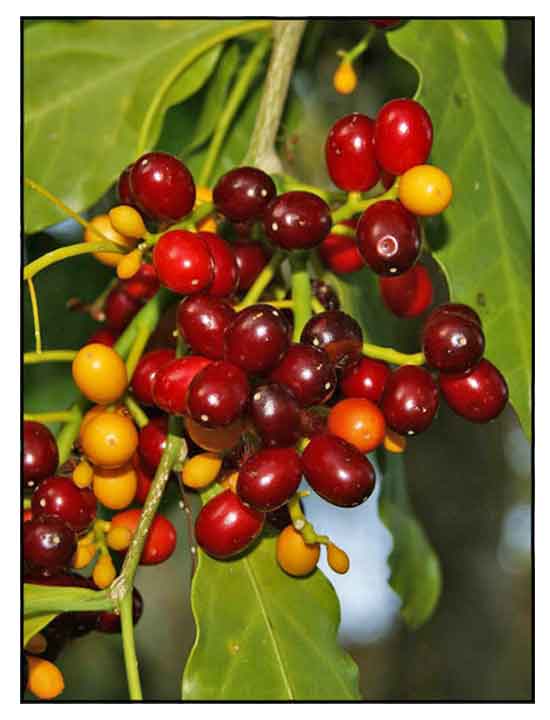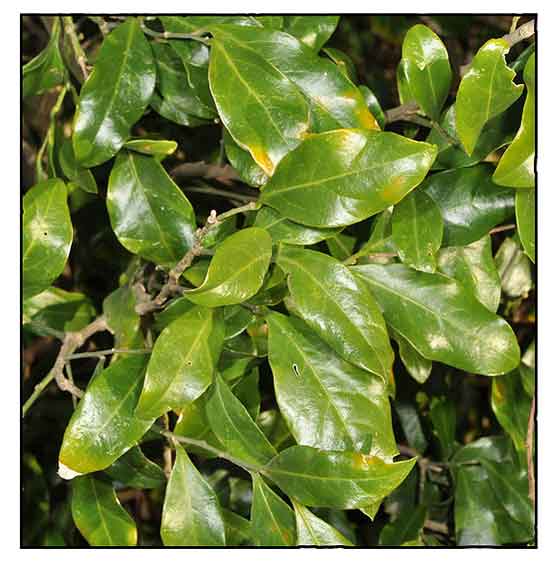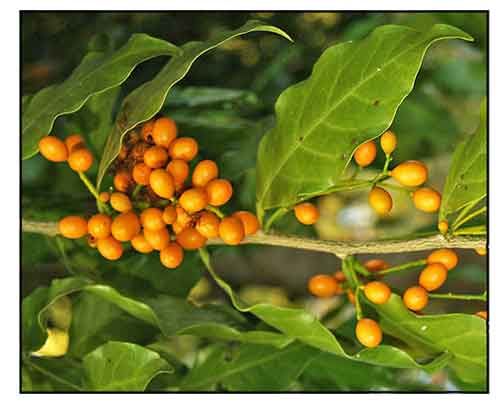
Family • Opiliaceae
Malakabuan
Liyong-liyong
Champereia manillana (Blume) Merr.
FALSE OLIVE
Tai wan shan you
| Scientific names | Common names |
| Apeng (Ilk.) | |
| Cansjera manillana Blume      | Garimo (Tag.) |
| Champereia manillana (Blume) Merr.      | Gelenjub (Mindanao) |
| Opilia manillana (Blume) Bail.      | Getipun (Mindanao) |
| Accepted infraspecifics (2) | Ichikamanok (Tag.) |
| Champereia manillana var. longistaminea (W.Z.Li)  H.S.Kiu    | Laniti (Palawan) |
| Champereia manillana var. manillana  | Liong-liong (Tag.) |
| Liyong-liyong (Tag.) | |
| Luingluing (Tag.) | |
| Malakabuan (Tag.) | |
| Malalukban (Tag.) | |
| Marisparis (Tag.) | |
| Panalayapin (Tagb.) | |
| Panalayapen (Ilk.) | |
| Sulanmanok (Sbl.) | |
| Talaminuk (Sub.) | |
| Malulukban (Iv.) | |
| Duro-manok (Palawan) | |
| False olive (Engl.) | |
| Manila champereia (Engl.) | |
| Manila cypress (Engl.) | |
| Manila false cypress (Engl.) | |
| Manila vigna (Engl.) | |
| False olive (Engl.) | |
| Champereira manillana is an accepted species. KEW: Plants of the World Online | |
| Other vernacular names |
| AMBOINA: Sayor garing. |
| CHINA: Tai wan shan you. |
| INDONESIA: Sayor garing, Cemperai, Siminyak. |
| MALAY: Belkan, Chemperai, Chimpri, Chipreh, Poko kuching-kuching. |
| SULAWESI: Borongbenisi, Kajuwatu. |
| SUMATRA: Tutup-mateh. |
| TALAUD IS.: Amaloana, Aramalu. |
| THAILAND: Phakwan, Phak pa, Phak puem, Sen. |
December 2023
![]()
 |
| Â Â Â Â Â Â Â Â Â Â Â Â Â Â Â Â Â Â Â Â Â Â Â Â Â PHOTOS / ILLUSTRATIONS |
| IMAGE SOURCE: Opiliaceae : Champereia manillana Fruits / Copyright © 2013 by Michael Agbayani Calaramo (contact: pieter.pelser@canterbury.ac.nz) [ref. DOL64647] / Non-Commercial Use / Image modified / Click on image or link to go to source page / Phytoimages.siu.edu |
| IMAGE SOURCE: Opiliaceae : Champereia manillana twig / (det/ by Michael Calaramo) / Copyright © 2015 by P B Pelser & J F Barcelona (contact: pieter.pelser@canterbury.ac.nz) [ref. DOL101342] / Non-Commercial Use / Image modified / Click on image or link to go to source page / Phytoimages.siu.edu |
| IMAGE SOURCE: Opiliaceae : Champereia manillana / Fruiting twig / (det/ by Michael Calaramo) / Copyright © 2013 by Michael Agbayani Calaramo (contact: pieter.pelser@canterbury.ac.nz) [ref. DOL64677] / Non-Commercial Use / Image modified / Click on image or link to go to source page / Phytoimages.siu.edu |
Additional
Sources and Suggested Readings |
• |
DOI: It is not uncommon for links on studies/sources to change. Copying and pasting the information on the search window or using the DOI (if available) will often redirect to the new link page. (Citing and Using a (DOI) Digital Object Identifier) |
| Â Â Â Â Â Â Â Â Â Â Â Â Â Â Â Â Â Â Â Â Â Â Â Â Â Â Â Â Â Â List of Understudied Philippine Medicinal Plants |
| Â Â Â Â Â Â Â Â Â Â Â Â Â Â Â Â Â Â Â Â Â New plant names needed The compilation now numbers over 1,300 medicinal plants. While I believe there are hundreds more that can be added to the collection, they are becoming more difficult to find. If you know of a plant to suggest for inclusion, please email the info: local plant name (if known), any known folkloric medicinal use, scientific name (most helpful), and, if possible, a photo. Your help will be greatly appreciated. |
• |
 |




